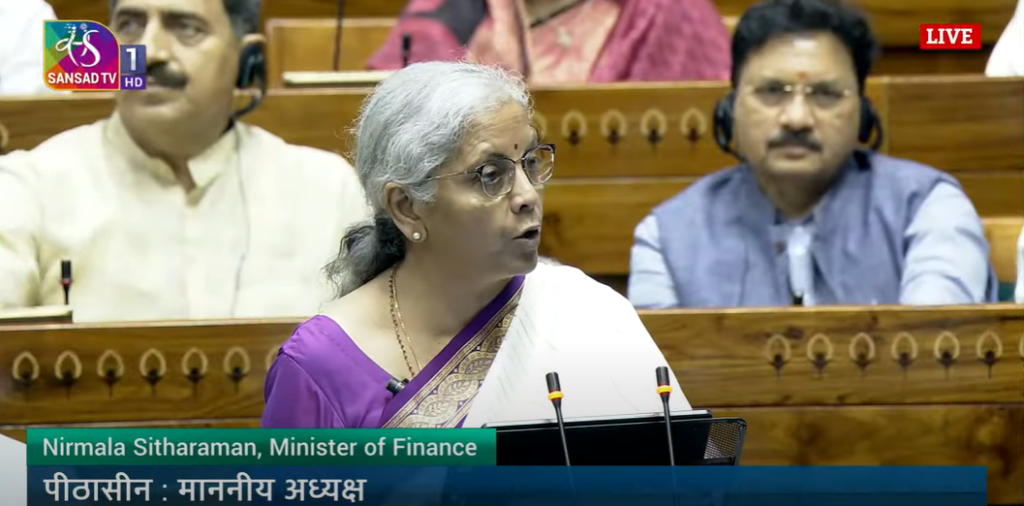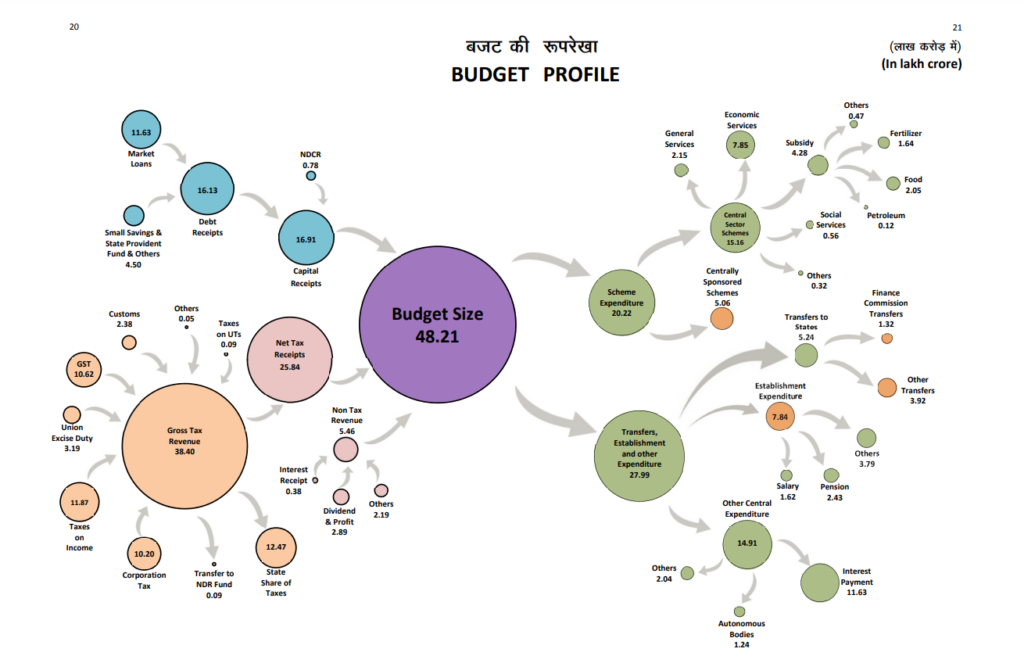Income Tax 2024-2025; A Guide, Rules, New Tax Slabs, Updates

On 23rd July FM Nirmala Sitharaman introduced a new income tax 2024-2025 regime at the union budget session 2024. However, this time the 2024 budget is designed to support farmers, the middle class, women, MSMEs, youth, etc. Well, for the middle-class and Neo-Middle-class new provisions and tax regimes had been introduced to ease the burden from inflation of commodities and increase the saving for personal development.

This blog will cover all the aspects related to the new Income tax 2024-2025 to help you as a guide, understanding new tax slabs, and updates. The 2024 budget session was unique (according to many experts) and held the long-term development vision of “Vikshit Bharat”.
Updates in New Tax Slab Regime (An Overview)
FM Nirmala Sitharam revised the new tax slab structure according to the Assessment Year of 2024-2025.
| Revised Total Income | New Tax Rate % |
| Upto ₹3 Lk | nil |
| ₹3Lk – ₹7 Lk | 5% |
| ₹7Lk – ₹10 Lk | 10% |
| ₹10Lk – ₹12 Lk | 15% |
| ₹12 Lk- ₹15 LK | 20% |
| More than >₹15 Lk | 30% |
- Under the new tax regime, ₹75000 of standard deduction increased for the salaried individual for the FY 2024-2025.
- The deduction limit for family pension increased from ₹15K to ₹25K.
- The exception limit of LTCG increased from ₹1 LK to ₹1.25 LK (@rate % of 10% to 12.5%)
- The exception limit rate of STCG increased from 15% to 20%. (as it will be applicable from 23rd July onwards)
- Announcement of special TDS rates on specific payments (reduced from 5% to 2%).
- The government omitted the U/s 194F of Mutual Fund UTI (used to charge 20% on repurchasing units of mutual funds)
- 0.1% Reduction in E-commerce TDS from 1%.
- Omission of Angel tax from the various income sources of the government.
- 0.02% to 1% increment on STT for Future and Options.
Revised Tax Slab According to Various Age Groups (Income Tax 2024-2025)
The government introduced various tax slabs, according to diverse age groups, including those below 60, >60-80, or 80-80+years. Here are the following tables;
Table of <60 years old Anytime During the Previous Year (Resident or Non-Resident)
This includes both old and new tax regimes with revised rates and categories.
| Old Tax Regime | New Tax Regime u/s 115BAC | ||
| Income Tax Slab | Income Tax Rate | Income Tax Slab | Income Tax Rate |
| Up to ₹ 2,50,000 | Nil | Up to ₹ 3,00,000 | Nil |
| ₹ 2,50,001 – ₹ 5,00,000 | 5% above ₹ 2,50,000 | ₹ 3,00,001 – ₹ 6,00,000 | 5% above ₹ 3,00,000 |
| ₹ 5,00,001 – ₹ 10,00,000 | ₹ 12,500 + 20% above ₹ 5,00,000 | ₹ 6,00,001 – ₹ 9,00,000 | ₹ 15,000 + 10% above ₹ 6,00,000 |
| Above ₹ 10,00,000 | ₹ 1,12,500 + 30% above ₹ 10,00,000 | ₹ 9,00,001 – ₹ 12,00,000 | ₹ 45,000 + 15% above ₹ 9,00,000 |
| ₹ 12,00,001 – ₹ 15,00,000 | ₹ 90,000 + 20% above ₹ 12,00,000 | ||
| Above ₹ 15,00,000 | ₹ 1,50,000 + 30% above ₹ 15,00,000 | ||
Table of >60 or 80 years old Anytime During the Previous Year (Resident or Non-Resident)
This includes both old and new tax regimes with revised rates and categories.
| Old Tax Regime | New Tax Regime u/s 115BAC | ||
| Income Tax Slab | Income Tax Rate | Income Tax Slab | Income Tax Rate |
| Up to ₹ 3,00,000 | Nil | Up to ₹ 3,00,000 | Nil |
| ₹ 3,00,001 – ₹ 5,00,000 | 5% above ₹ 3,00,000 | ₹ 3,00,001 – ₹ 6,00,000 | 5% above ₹ 3,00,000 |
| ₹ 5,00,001 – ₹ 10,00,000 | ₹ 10,000 + 20% above ₹ 5,00,000 | ₹ 6,00,001 – ₹ 9,00,000 | ₹ 15,000 + 10% above ₹ 6,00,000 |
| Above ₹ 10,00,000 | ₹ 1,10,000 + 30% above ₹ 10,00,000 | ₹ 9,00,001 – ₹ 12,00,000 | ₹ 45,000 + 15% above ₹ 9,00,000 |
| ₹ 12,00,001 – ₹ 15,00,000 | ₹ 90,000 + 20% above ₹ 12,00,000 | ||
| Above ₹ 15,00,000 | ₹ 1,50,000 + 30% above ₹ 15,00,000 | ||
Table of >80 or 80 years old Anytime During the Previous Year (Resident or Non-Resident)
This includes both old and new tax regimes with revised rates and categories.
| Old Tax Regime | New Tax Regime u/s 115BAC | ||
| Income Tax Slab | Income Tax Rate | Income Tax Slab | Income Tax Rate |
| Up to ₹ 5,00,000 | Nil | Up to ₹ 3,00,000 | Nil |
| ₹ 5,00,001 – ₹ 10,00,000 | 20% above ₹ 5,00,000 | ₹ 3,00,001 – ₹ 6,00,000 | 5% above ₹ 3,00,000 |
| Above ₹ 10,00,000 | ₹ 1,00,000 + 30% above ₹ 10,00,000 | ₹ 6,00,001 – ₹ 9,00,000₹ | ₹ 15,000 + 10% above ₹ 6,00,000 |
| ₹ 9,00,001 – ₹ 12,00,000 | ₹ 45,000 + 15% above ₹ 9,00,000 | ||
| ₹ 12,00,001 – ₹ 15,00,000 | ₹ 90,000 + 20% above ₹ 12,00,000 | ||
| Above ₹ 15,00,000 | ₹ 1,50,000 + 30% above ₹ 15,00,000 | ||
Note; Surcharges Under the Revised Tax Regime 2024-2025
Under the revised version surcharges are applicable to consolidate the new and old tax regimes 2024-2025.
| Total Income | Old Tax Rates % | New Tax Rate% (new surcharges rates applicable) |
| ₹50 lk | Nil | Nil |
| >₹50 lk to ₹1 Cr. | 10% | 10% |
| >₹1 cr. to ₹2 cr. | 15% | 15% |
| >₹2 cr. to 5 cr. | 25% | 25% |
| >₹5 cr. | 37% | 25% |
Note;
- The last surcharge rates of 25% and 37%, can treated as exemptions for specific u/s of 11A, 112, 112A, and dividend income.
- Which will be charged a @15% rate (maximum rate) except the following section must be entertained of u/s 115- A, AB, AC, ACA, & E.
Rebate U/S 87A Under Income Tax Regime 2024-2025
The new rebate applies to the residential individual. Up to 100% rebate subjected, to the maximum limit under the income tax rate 2024-2025.
| Total Income | Old Tax Regime | New Tax Regime |
| Rebate under Section 87A Applicable | ||
| Up to Rs. 5 Lakh | up to Rs.12,500 is applicable for resident individuals {not exceed >₹5,00,000} | up to Rs.25,000 is applicable for resident individuals {not exceed >₹7,00,000} |
| From 5 Lakhs to 7 Lakhs | NIL | |
- Non-residential individuals (NRI) cannot entertain this rebate.
Marginal & Health and Education CESS (ITR 2024-2025)
The marginal reliefs are applied on exceeding the limit of surcharges on additional income. It is a relief that applies to the surcharges. The surcharges shall not exceed the total income prescribed in the above table (1).
Table on Marginal Relief on Surcharges
| Net Income Range | Marginal Relief | |
| Exceeds (Rs.) | Does not exceed (Rs.) | |
| 50 Lakh | 1 Crore | The surcharge shall not exceed the total income of ₹50 lk or the total income not exceed (>₹50 lk) |
| 1 Crore | 2 Crore | The surcharge shall not exceed the total income of ₹2 crore or the total income not exceed (>₹1 crore) |
| 2 Crore | 5 Crore | The surcharge shall not exceed the total income of ₹2 crore or the total income not exceed (>₹2 crore) |
| 5 Crore | The surcharge shall not exceed the total income of ₹5 crore or the total income not exceed (>₹5 crore) | |

Health and Education CESS
Under the new revised income tax regime 2024-2025, a @4% cess shall be applicable, on the above tax slab rates with surcharges.
Conclusion
The government revised the tax regime to diversify the new opportunities for the middle-neo-middle taxpayers. The FM takes the initiative to control the inflation rate (currently 4.83% according to AICPI). It’s believed that this new revised tax regime, helps to ease the burden, especially on the middle class. As we can see FM brings relief to new tax regime rates by increasing the savings up to ₹75000. Increment in deduction on tax and family pension an additional increment on improving the saving of middle-class. Various initiatives, such as “Employment-Linked Incentive”. A first-time intern will be paid up to ₹15000 in DBT under EPFO in three installments.
Although, various profound experts conclude that the tax regime of 2024, opening new opportunities for the middle class, poor, and youth still there are more areas to be improved. However, no exemption for The LTCG exemption limit went from ₹1 LK to ₹1.25 LK (from a rate of 10% to 12.5%). The STCG’s exception limit rate went up from 15% to 20%. (because it will be in effect starting on July 23rd).
However, the government announced to decrease in TDS rates from 5% to 2% on particular payments. Abolish The U/s 194F of the Mutual Fund UTI of 20% fee on repurchasing mutual fund units. 0.1% from 1% reduction on E-commerce TDS. Many experts see the Tax deduction at source as a necessary extra income for the government.

To provide middle-class and neo-middle-class taxpayers with more options, thus the government changed the tax system. The vision of “Vikshit Bharat” is to empower the lower class, women, and youth to recreate a firm ground to sustain and exploit the labor-intensive agenda. This will build a firm ground for MSMEs to recruit talents from the ground and increase consumer capacity. This will boost production and technical skill development.
A lot of experts say that the 2024 budget session was special since it included the “Vikshit Bharat” long-term development vision. However, investors had faced some drawbacks from the government.
